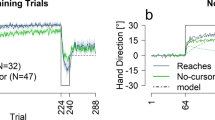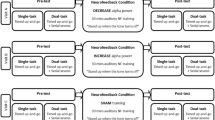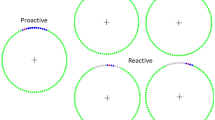Abstract
Facilitation of implicit learning of a hand motor sequence after a single session of neurofeedback training of alpha power recorded from the motor cortex has been shown in healthy individuals (Ros et al., Biological Psychology 95:54–58, 2014). This facilitation effect could be potentially applied to improve the outcome of rehabilitation in patients with impaired hand motor function. In the current study a group of ten patients diagnosed with cerebral palsy trained reduction of alpha power derived from brain activity recorded from right and left motor areas. Training was distributed in three periods of 8 min each. In between, participants performed a serial reaction time task with their non-dominant hand, to a total of five runs. A similar procedure was repeated a week or more later but this time training was based on simulated brain activity. Reaction times pooled across participants decreased on each successive run faster after neurofeedback training than after the simulation training. Also recorded were two 3-min baseline conditions, once with the eyes open, another with the eyes closed, at the beginning and end of the experimental session. No significant changes in alpha power with neurofeedback or with simulation training were obtained and no correlation with the reductions in reaction time could be established. Contributions for this are discussed.





Similar content being viewed by others
References
Ayers, M. E. (2004). Neurofeedback for cerebral palsy. Journal of Neurotherapy, 8, 93–94.
Barry, R., Clarke, A., Johnstone, S., Magee, C., & Rushby, J. (2007). EEG differences between eyes-closed and eyes-open resting conditions. Clinical Neurophysiology, 118(12), 2765–2773.
Chinier, E., N’Guyen, S., Lignon, G., Ter Minassian, A., Richard, I., & Dinomais, M. (2014). Effect of motor imagery in children with unilateral cerebral palsy: fMRI study. PloS One, 9(4), e93378.
Daly, I., Billinger, M., Laparra-Hernandez, J., Aloise, F., Garcia, M. L., Faller, J., et al. (2013). On the control of brain-computer interfaces by users with cerebral palsy. Clinical Neurophysiology, 124, 1787–1797.
Daly, I., Faller, J., Scherer, R., Sweeney-Reed, C. M., Nasuto, S. J., Billinger, M., et al. (2014). Exploration of the neural correlates of cerebral palsy for sensorimotor BCI control. Frontiers in Neuroengineering, 7, 20. doi:10.3389/fneng.2014.00020
Dekker, M., Sitskoorn, M., Denissen, A., & van Boxtel, G. (2014). The time-course of alpha neurofeedback training effects in healthy participants. Biological Psychology, 95, 70–73. doi:10.1016/j.biopsycho.2013.11.014.
Delorme, A., & Makeig, S. (2004). EEGLAB: An open source toolbox for analysis of single-trial EEG dynamics. Journal of Neuroscience Methods, 134, 9–21.
Eliasson, A., Krumlinde, S., Rösblad, B., Beckung, E., Arner, M., AM, Ö., et al. (2006). The Manual Ability Classification System (MACS) for children with cerebral palsy: Scale development and evidence of validity and reliability. Developmental Medicine and Child Neurology, 48, 549–554.
Eyre, J. A., Smith, M., Dabydeen, L., Clowry, G. J., Petacchi, E., Battini, R., et al. (2007). Is hemiplegic cerebral palsy equivalent to amblyopia of the corticospinal system? Annals of Neurology, 62(5), 493–503.
Fregni, F., Boggio, P. S., Mansur, C. G., Wagner, T., Ferreira, M. J., Lima, M. C., et al. (2005). Transcranial direct current stimulation of the unaffected hemisphere in stroke patients. Neuroreport, 16(14), 1551–1555.
Gruzelier, J. H., Foks, M., Steffert, T., Chen, M. J.-L., & Ros, T. (2014). Beneficial outcome from EEG-neurofeedback on creative music performance, attention and well-being in school children. Biological Psychology, 95, 86–95.
Keizer, A. W., Verment, R. S., & Hommel, B. (2010). Enhancing cognitive control through neurofeedback: A role of gamma-band activity in managing episodic retrieval. Neuroimage, 49, 3404–3413.
Leins, U., Goth, G., Hinterberger, T., Klinger, C., Rumpf, N., & Strehl, U. (2007). Neurofeedback for children with ADHD: A comparison of SCP and Theta/Beta protocols. Applied Psychophysiology and Biofeedback, 32, 73–88.
Neuper, C., Muller, G. R., Kubler, A., Birbaumer, N., & Pfurtscheller, G. (2003). Clinical application of an EEG-based brain-computer interface: A case study in a patient with severe motor impairment. Clinical Neurophysiology, 114, 399–409.
Nissen, M., & Bullemer, P. (1987). Attentional requirements of learning: Evidence from performance measures. Cognitive Psychology, 19, 1–32.
Oldfield, R. (1971). The assessment and analysis of handedness: The Edinburgh inventory. Neuropsychologia, 9(1), 97–113.
Palisano, R., Rosenbaum, P., Walter, S., Russell, D., Wood, E., & Galuppi, B. (1997). Development and reliability of a system to classify gross motor function in children with cerebral palsy. Developmental Medicine & Child Neurology, 39(4), 214–223.
Pascual-Leone, A., Grafman, J., & Hallett, M. (1994). Modulation of cortical motor output maps during development of implicit and explicit knowledge. Science, 263, 1287–1289.
Pfurtscheller, G., Neuper, C., Andrew, C., & Edlinger, G. (1997). Foot and hand area mu rhythms. International Journal of Psychophysiology, 26, 121–135.
Reiner, M., Rozengurt, R., & Barnea, A. (2014). Better than sleep: Theta neurofeedback training accelerates memory consolidation. Biological Psychology, 95, 45–53.
Rethlefsen, S., Deidre, D., & Kay, R. (2010). Classification systems in cerebral palsy. Orthopedic Clinics of North America, 41, 457–467.
Robertson, E. (2007). The serial reaction time task: Implicit motor skill learning? The Journal of Neuroscience, 27(38), 10073–10075. doi:10.1523/JNEUROSCI.2747-07.2007.
Ros, T., Munneke, M. A., Ruge, D., Gruzelier, J. H., & Rothwell, J. C. (2010). Endogenous control of waking brain rhythms induces neuroplasticity in humans. European Journal of Neuroscience, 31(4), 770–778.
Ros, T., Munneke, M. A. M., Parkinson, L. A., & Gruzelier, J. H. (2014). Neurofeedback facilitation of implicit motor learning. Biological Psychology, 95, 54–58.
Rosenbaum, P., Paneth, N., Leviton, A., Goldstein, M., Bax, M., Damiano, D., et al. (2007). A report: The definition and classification of cerebral palsy April 2006. Developmental Medicine and Child Neurology, 109, 8–14.
Rosenbaum, P. L., Palisano, R. J., Bartlett, D. J., Galuppi, B. E., & Russell, D. J. (2008). Development of the gross motor function classification system for cerebral palsy. Developmental Medicine & Child Neurology, 50(4), 249–253.
Sauseng, P., Klimesch, W., Gerloff, C., & Hummel, F. C. (2009). Spontaneous locally restricted EEG alpha activity determines cortical excitability in the motor cortex. Neuropsychologia, 47(1), 284–288.
Staudt, M. (2010). Reorganization after pre-and perinatal brain lesions*. Journal of Anatomy, 217(4), 469–474.
Staudt, M., Grodd, W., Gerloff, C., Erb, M., Stitz, J., & Krägeloh-Mann, I. (2002). Two types of ipsilateral reorganization in congenital hemiparesis A TMS and fMRI study. Brain: A Journal of Neurology, 125(10), 2222–2237.
Strehl, U. (2013). Neurofeedback. Stuttgart: Kohlhammer.
Strehl, U., Leins, U., Goth, G., Klinger, C., Hinterberger, T., & Birbaumer, N. (2006). Self-regulation of slow cortical potentials: A new treatment for children with attention-deficit/hyperactivity disorder. Pediatrics, 118, e1530–e1540.
Wood, E., & Rosenbaum, P. (2000). The gross motor function classification system for cerebral palsy: A study of reliability and stability over time. Developmental Medicine & Child Neurology, 42(05), 292–296.
Acknowledgements
Experimental work supported by the Buhl-Strohmaier Foundation and the Kraußianum Foundation. Research group financed by the Würth Foundation. We thank the company Mindfield® Biosystems Ltd., Germany, for lending us the equipment for neurofeedback training and brain recordings.
Author information
Authors and Affiliations
Corresponding author
Ethics declarations
Conflict of interest
The authors declare that they have no conflict of interest.
Rights and permissions
About this article
Cite this article
Alves-Pinto, A., Turova, V., Blumenstein, T. et al. Implicit Learning of a Finger Motor Sequence by Patients with Cerebral Palsy After Neurofeedback. Appl Psychophysiol Biofeedback 42, 27–37 (2017). https://doi.org/10.1007/s10484-017-9349-1
Published:
Issue Date:
DOI: https://doi.org/10.1007/s10484-017-9349-1




